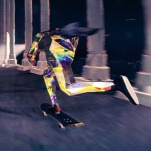But the failure to delve deeper into individual pieces is virtually the only flaw in a fascinating set where every installment comes freighted with political and historical significance. Stretching from the early silent films of the '20s to a stop-motion short from 1984, the set vilifies capitalists (particularly Americans), touts Communist values, repeatedly re-lives the Bolshevik Revolution, and bemoans the fate of victimized workers in other countries. The four discs—"American Imperialists," "Fascist Barbarians," "Capitalist Sharks," and "Onward To The Shining Future: Communism"—break the contents down into categories, which makes for some redundancy, but allows comparisons of ideologies and images over time. Not that much changes; the animation matures greatly, but the visual shorthand stays much the same. Workers are strong-chinned, noble, and generic, capitalists are fat, piggish cigar-chompers, and foreigners are ugly caricatures similar to those seen in American World War II propaganda—even though several of these shorts specifically emphasize racial brotherhood, and condemn how America exploits, abuses, and segregates its African-American citizens.
Cultural historians are likely to find the most value in installments like 1924's "Soviet Toys," the first animated Soviet film. This crude silent is packed with bizarre political-cartoon metaphors, as for instance a worker and a peasant merge into a creepy conjoined monstrosity to stomp tax money out of an entrepreneur's fat belly and into the people's bank. Many of the shorts also incorporate old film footage, vintage photography, and pro-Soviet period songs. But for straight-up animation fans, the set's treasures are pieces like 1949's Disney-style jazz condemnation "Someone Else's Voice," or 1979's "Shooting Range," which tracks the trials of an exploited worker via gorgeously fluid psychedelic imagery. The people who made these shorts clearly knew that humor and beauty help the state-mandated messages go down, and plenty of both come across in this extensive collection.
Key features: Just the featurettes, which help clarify the more abstruse imagery.








































